2002 FORD F SERIES MOTORHOME AND COMMERCIAL CHASSIS adding oil
[x] Cancel search: adding oilPage 10 of 104
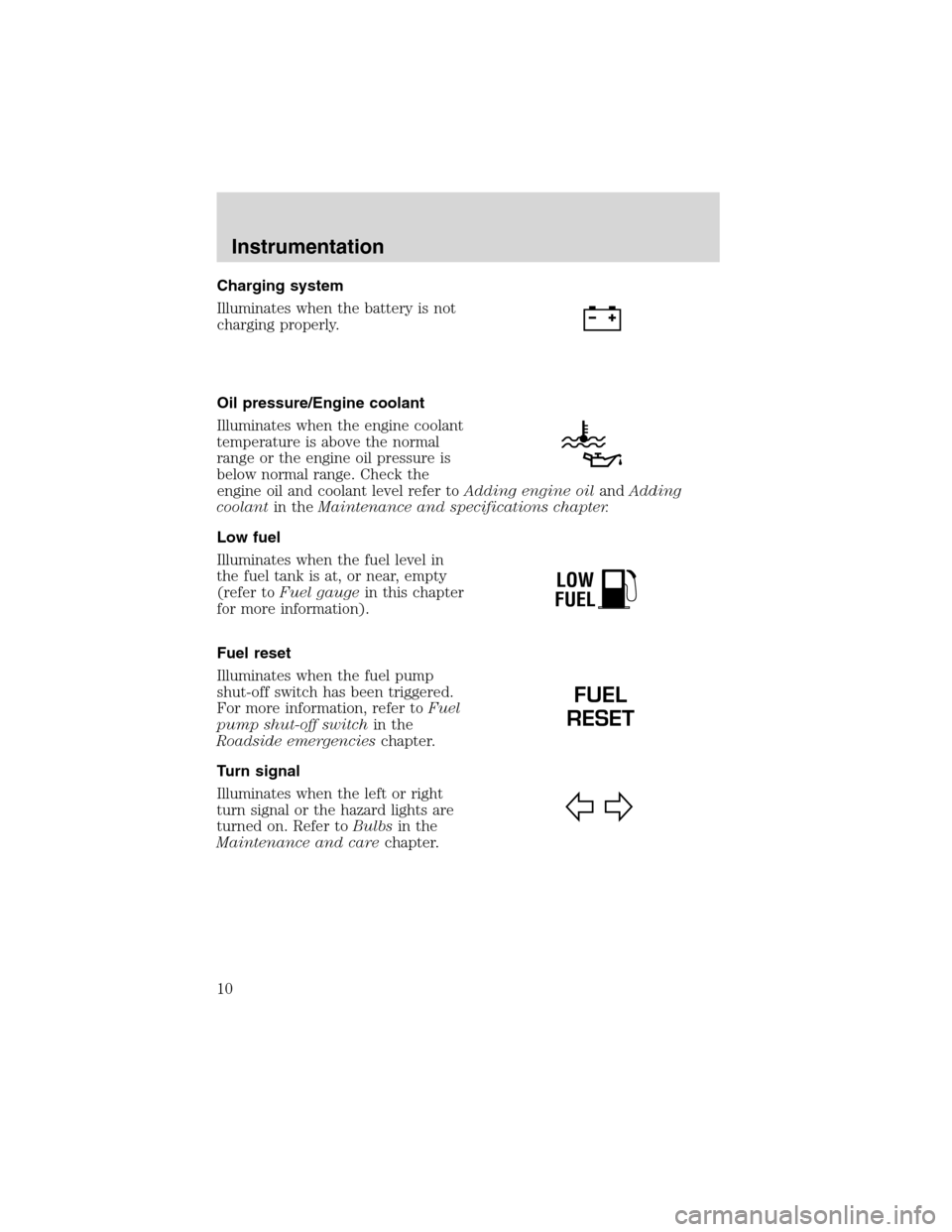
Charging system
Illuminates when the battery is not
charging properly.
Oil pressure/Engine coolant
Illuminates when the engine coolant
temperature is above the normal
range or the engine oil pressure is
below normal range. Check the
engine oil and coolant level refer toAdding engine oilandAdding
coolantin theMaintenance and specifications chapter.
Low fuel
Illuminates when the fuel level in
the fuel tank is at, or near, empty
(refer toFuel gaugein this chapter
for more information).
Fuel reset
Illuminates when the fuel pump
shut-off switch has been triggered.
For more information, refer toFuel
pump shut-off switchin the
Roadside emergencieschapter.
Turn signal
Illuminates when the left or right
turn signal or the hazard lights are
turned on. Refer toBulbsin the
Maintenance and carechapter.
LOW
FUEL
FUEL
RESET
Instrumentation
10
Page 62 of 104
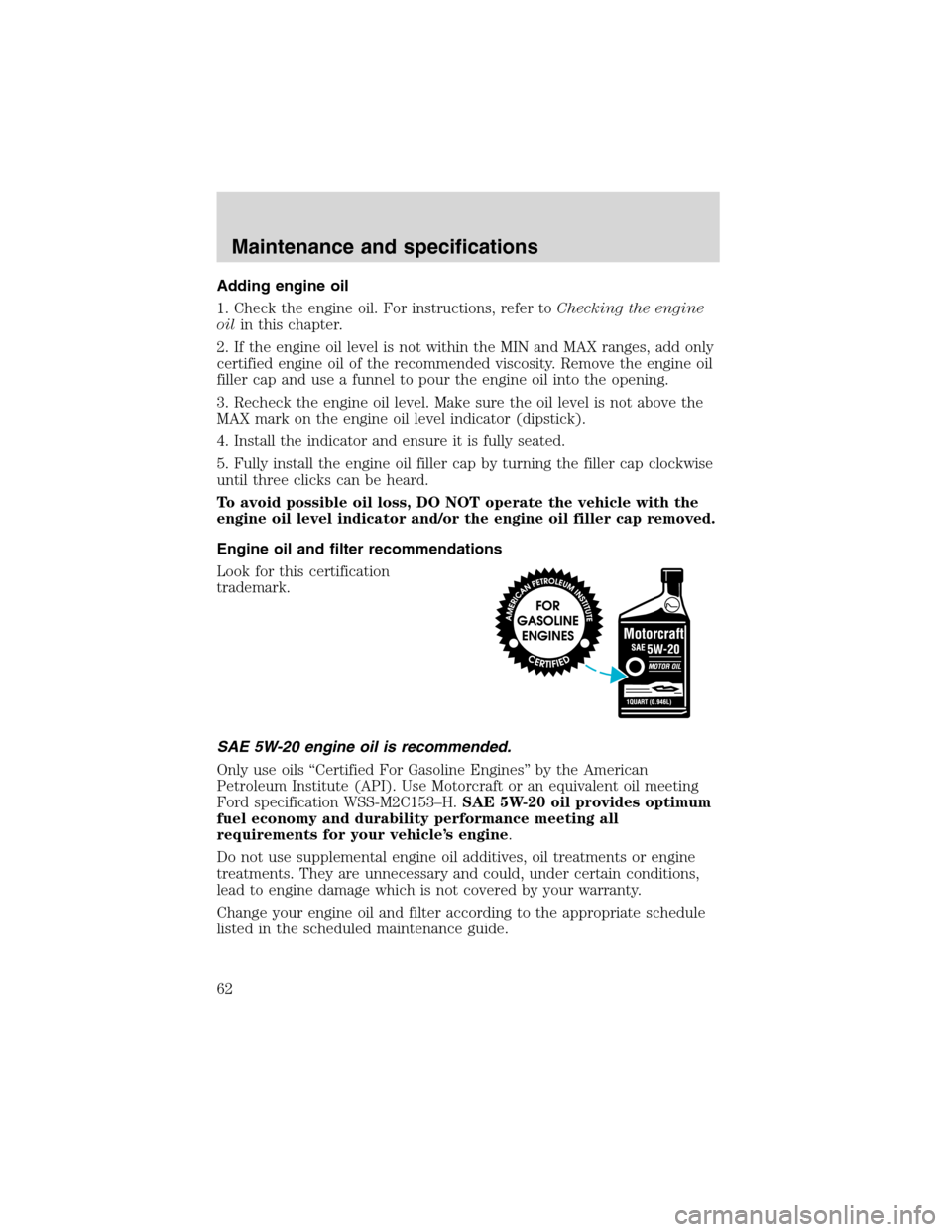
Adding engine oil
1. Check the engine oil. For instructions, refer toChecking the engine
oilin this chapter.
2. If the engine oil level is not within the MIN and MAX ranges, add only
certified engine oil of the recommended viscosity. Remove the engine oil
filler cap and use a funnel to pour the engine oil into the opening.
3. Recheck the engine oil level. Make sure the oil level is not above the
MAX mark on the engine oil level indicator (dipstick).
4. Install the indicator and ensure it is fully seated.
5. Fully install the engine oil filler cap by turning the filler cap clockwise
until three clicks can be heard.
To avoid possible oil loss, DO NOT operate the vehicle with the
engine oil level indicator and/or the engine oil filler cap removed.
Engine oil and filter recommendations
Look for this certification
trademark.
SAE 5W-20 engine oil is recommended.
Only use oils “Certified For Gasoline Engines” by the American
Petroleum Institute (API). Use Motorcraft or an equivalent oil meeting
Ford specification WSS-M2C153–H.SAE 5W-20 oil provides optimum
fuel economy and durability performance meeting all
requirements for your vehicle’s engine.
Do not use supplemental engine oil additives, oil treatments or engine
treatments. They are unnecessary and could, under certain conditions,
lead to engine damage which is not covered by your warranty.
Change your engine oil and filter according to the appropriate schedule
listed in the scheduled maintenance guide.
Maintenance and specifications
62
Page 66 of 104
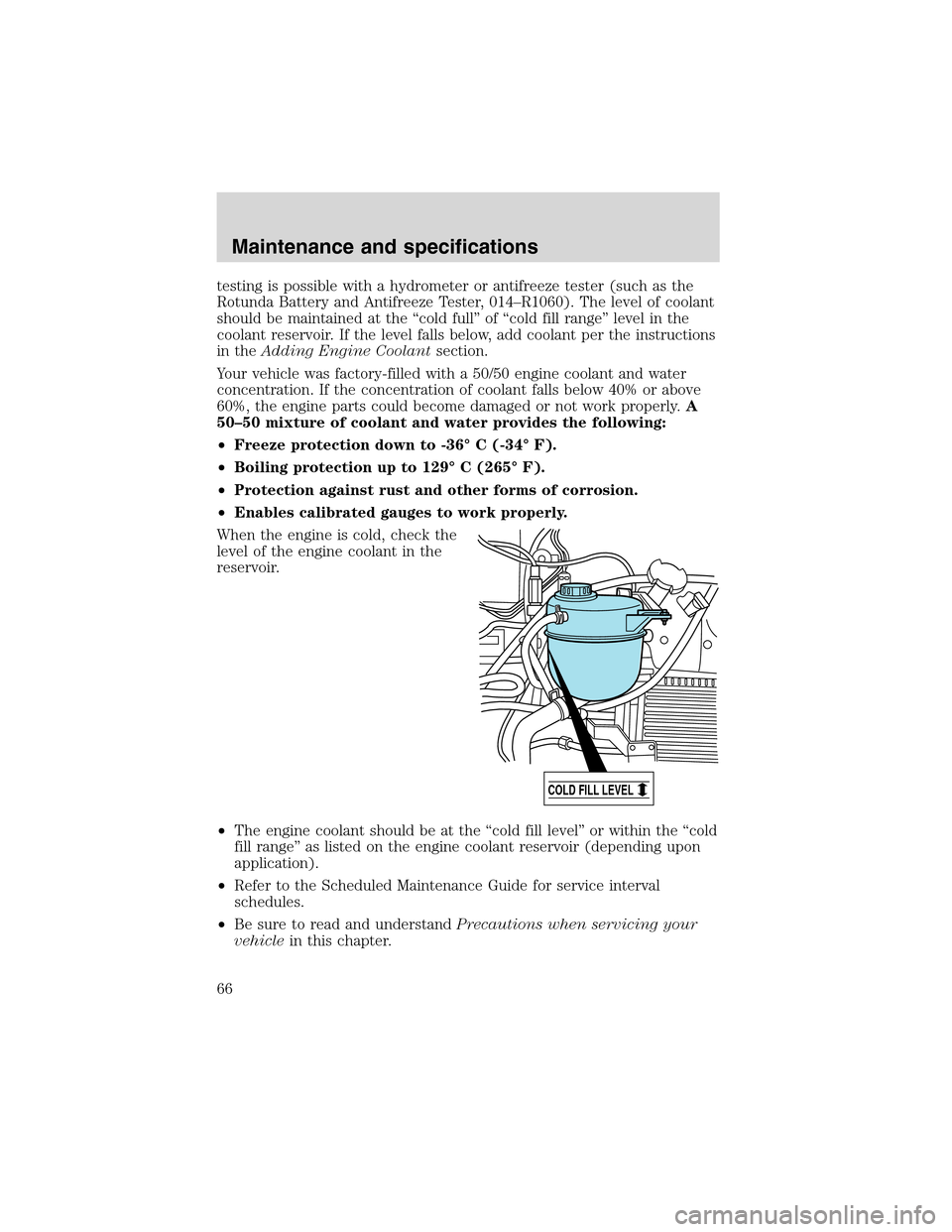
testing is possible with a hydrometer or antifreeze tester (such as the
Rotunda Battery and Antifreeze Tester, 014–R1060). The level of coolant
should be maintained at the “cold full” of “cold fill range” level in the
coolant reservoir. If the level falls below, add coolant per the instructions
in theAdding Engine Coolantsection.
Your vehicle was factory-filled with a 50/50 engine coolant and water
concentration. If the concentration of coolant falls below 40% or above
60%, the engine parts could become damaged or not work properly.A
50–50 mixture of coolant and water provides the following:
•Freeze protection down to -36° C (-34° F).
•Boiling protection up to 129° C (265° F).
•Protection against rust and other forms of corrosion.
•Enables calibrated gauges to work properly.
When the engine is cold, check the
level of the engine coolant in the
reservoir.
•The engine coolant should be at the “cold fill level” or within the “cold
fill range” as listed on the engine coolant reservoir (depending upon
application).
•Refer to the Scheduled Maintenance Guide for service interval
schedules.
•Be sure to read and understandPrecautions when servicing your
vehiclein this chapter.
COLD FILL LEVEL
Maintenance and specifications
66
Page 81 of 104
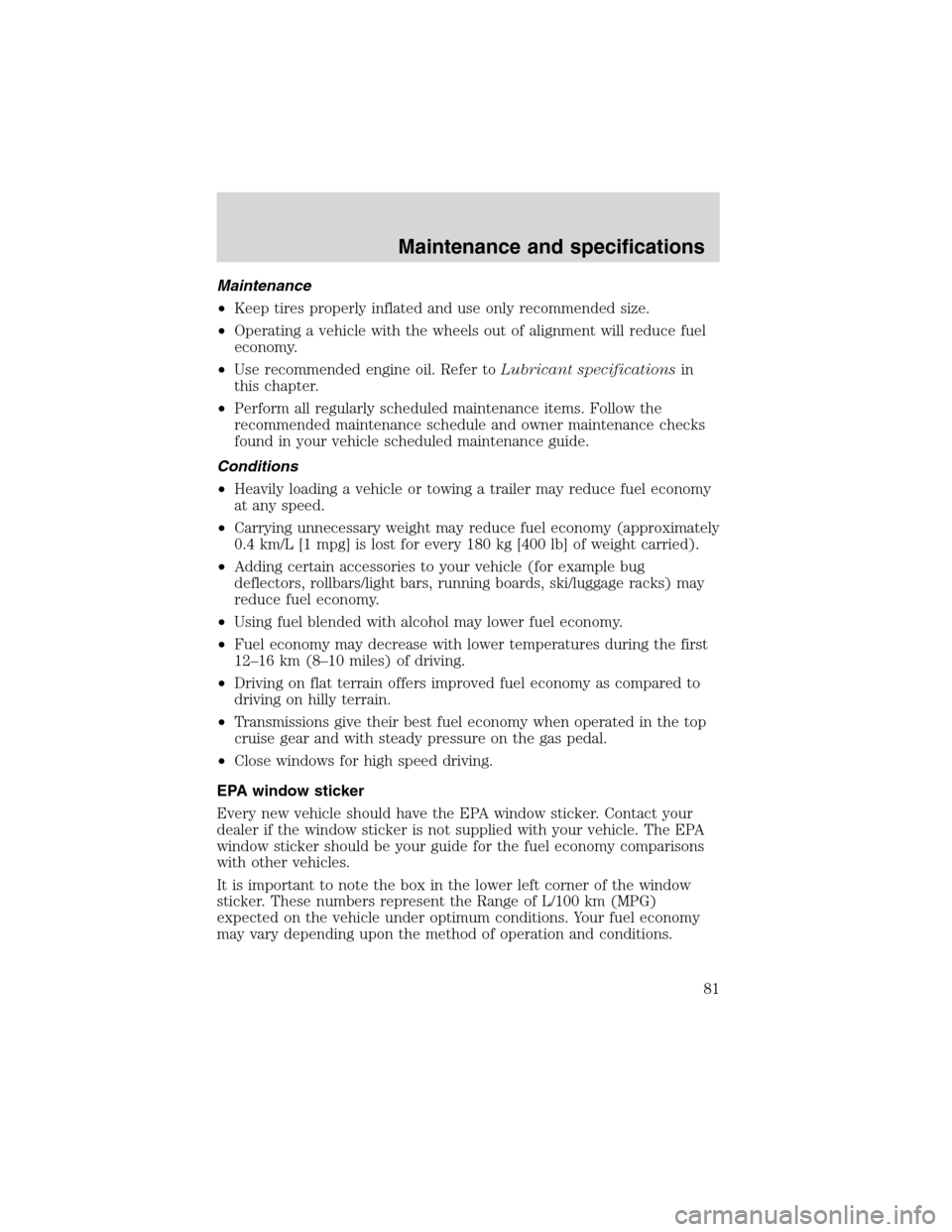
Maintenance
•Keep tires properly inflated and use only recommended size.
•Operating a vehicle with the wheels out of alignment will reduce fuel
economy.
•Use recommended engine oil. Refer toLubricant specificationsin
this chapter.
•Perform all regularly scheduled maintenance items. Follow the
recommended maintenance schedule and owner maintenance checks
found in your vehicle scheduled maintenance guide.
Conditions
•Heavily loading a vehicle or towing a trailer may reduce fuel economy
at any speed.
•Carrying unnecessary weight may reduce fuel economy (approximately
0.4 km/L [1 mpg] is lost for every 180 kg [400 lb] of weight carried).
•Adding certain accessories to your vehicle (for example bug
deflectors, rollbars/light bars, running boards, ski/luggage racks) may
reduce fuel economy.
•Using fuel blended with alcohol may lower fuel economy.
•Fuel economy may decrease with lower temperatures during the first
12–16 km (8–10 miles) of driving.
•Driving on flat terrain offers improved fuel economy as compared to
driving on hilly terrain.
•Transmissions give their best fuel economy when operated in the top
cruise gear and with steady pressure on the gas pedal.
•Close windows for high speed driving.
EPA window sticker
Every new vehicle should have the EPA window sticker. Contact your
dealer if the window sticker is not supplied with your vehicle. The EPA
window sticker should be your guide for the fuel economy comparisons
with other vehicles.
It is important to note the box in the lower left corner of the window
sticker. These numbers represent the Range of L/100 km (MPG)
expected on the vehicle under optimum conditions. Your fuel economy
may vary depending upon the method of operation and conditions.
Maintenance and specifications
81
Page 101 of 104
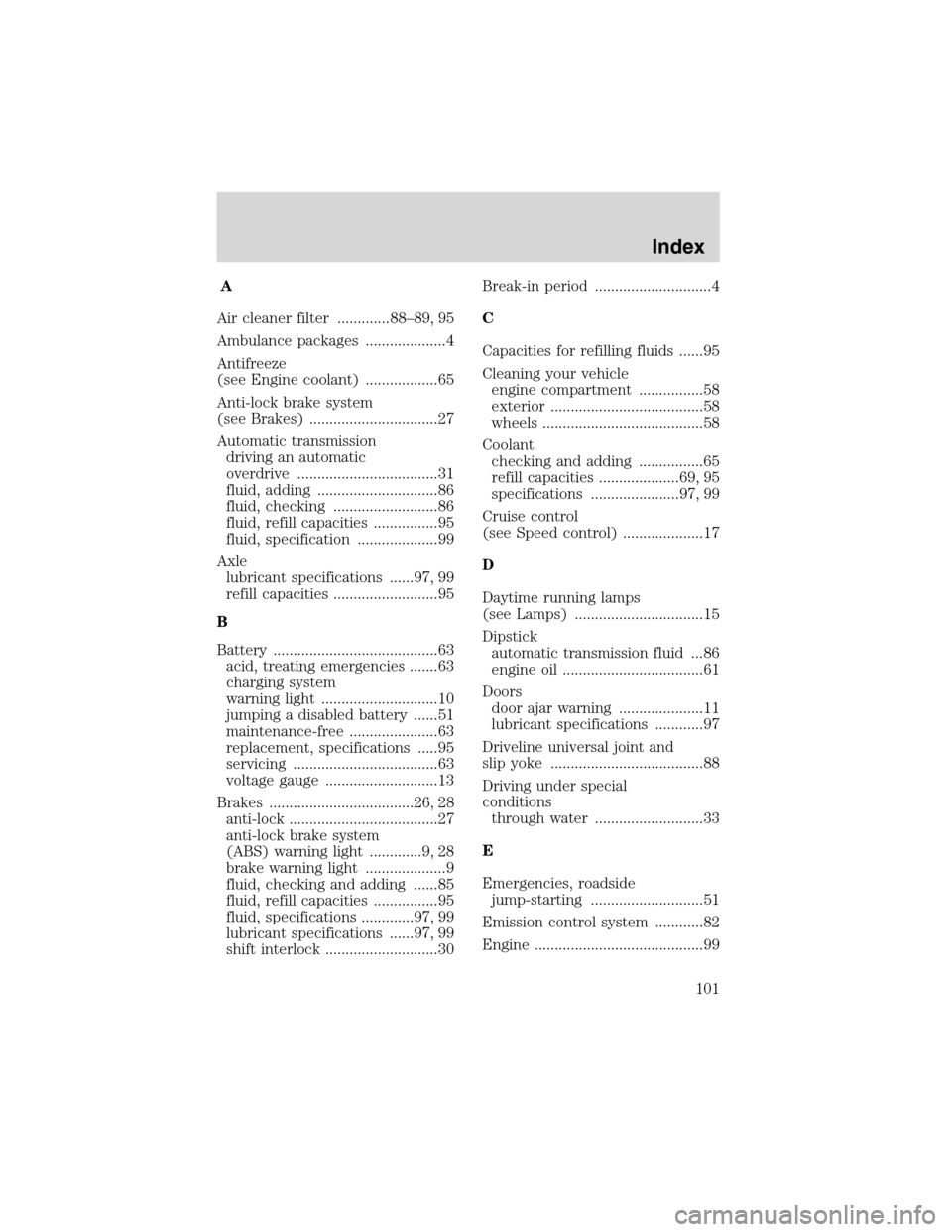
A
Air cleaner filter .............88–89, 95
Ambulance packages ....................4
Antifreeze
(see Engine coolant) ..................65
Anti-lock brake system
(see Brakes) ................................27
Automatic transmission
driving an automatic
overdrive ...................................31
fluid, adding ..............................86
fluid, checking ..........................86
fluid, refill capacities ................95
fluid, specification ....................99
Axle
lubricant specifications ......97, 99
refill capacities ..........................95
B
Battery .........................................63
acid, treating emergencies .......63
charging system
warning light .............................10
jumping a disabled battery ......51
maintenance-free ......................63
replacement, specifications .....95
servicing ....................................63
voltage gauge ............................13
Brakes ....................................26, 28
anti-lock .....................................27
anti-lock brake system
(ABS) warning light .............9, 28
brake warning light ....................9
fluid, checking and adding ......85
fluid, refill capacities ................95
fluid, specifications .............97, 99
lubricant specifications ......97, 99
shift interlock ............................30Break-in period .............................4
C
Capacities for refilling fluids ......95
Cleaning your vehicle
engine compartment ................58
exterior ......................................58
wheels ........................................58
Coolant
checking and adding ................65
refill capacities ....................69, 95
specifications ......................97, 99
Cruise control
(see Speed control) ....................17
D
Daytime running lamps
(see Lamps) ................................15
Dipstick
automatic transmission fluid ...86
engine oil ...................................61
Doors
door ajar warning .....................11
lubricant specifications ............97
Driveline universal joint and
slip yoke ......................................88
Driving under special
conditions
through water ...........................33
E
Emergencies, roadside
jump-starting ............................51
Emission control system ............82
Engine ..........................................99
Index
101
Page 102 of 104
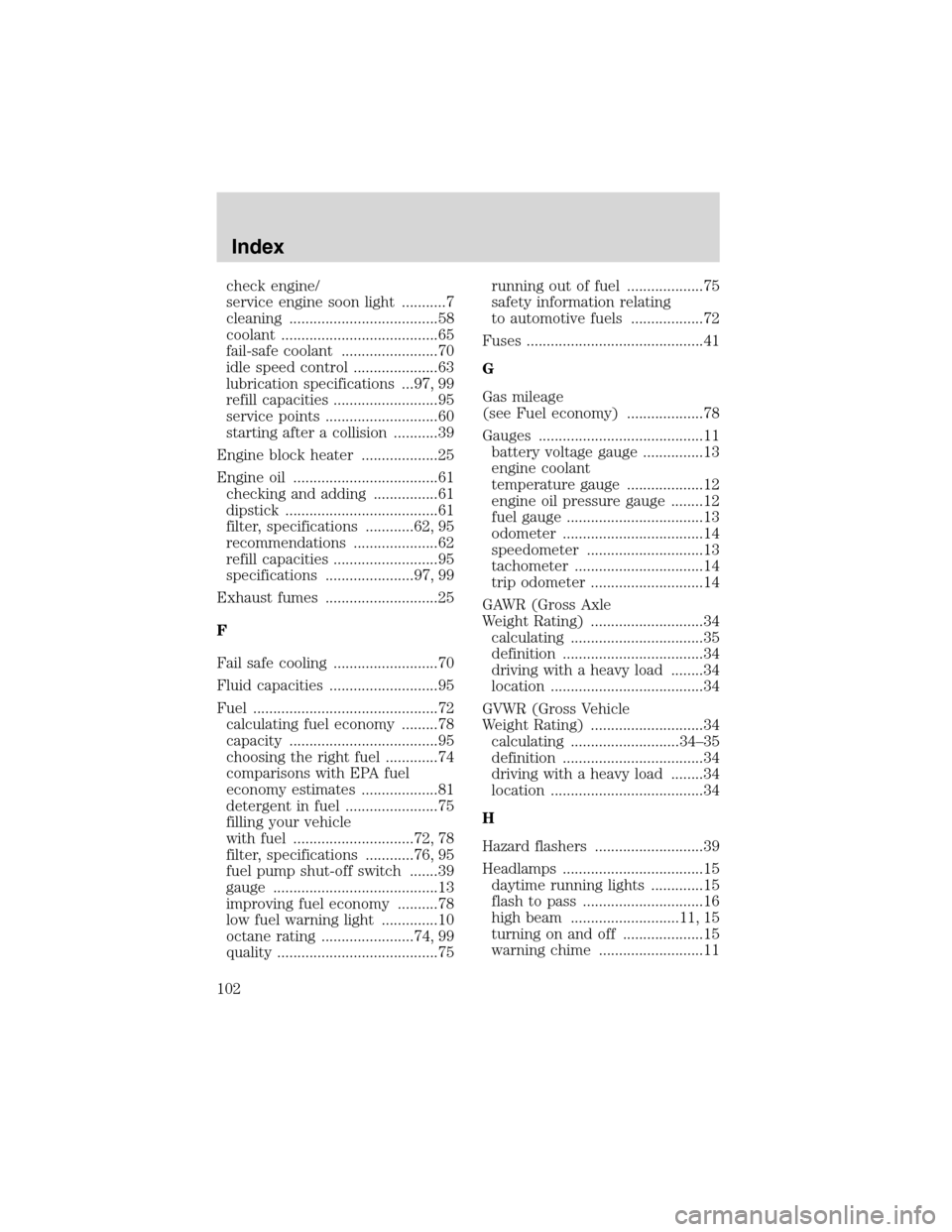
check engine/
service engine soon light ...........7
cleaning .....................................58
coolant .......................................65
fail-safe coolant ........................70
idle speed control .....................63
lubrication specifications ...97, 99
refill capacities ..........................95
service points ............................60
starting after a collision ...........39
Engine block heater ...................25
Engine oil ....................................61
checking and adding ................61
dipstick ......................................61
filter, specifications ............62, 95
recommendations .....................62
refill capacities ..........................95
specifications ......................97, 99
Exhaust fumes ............................25
F
Fail safe cooling ..........................70
Fluid capacities ...........................95
Fuel ..............................................72
calculating fuel economy .........78
capacity .....................................95
choosing the right fuel .............74
comparisons with EPA fuel
economy estimates ...................81
detergent in fuel .......................75
filling your vehicle
with fuel ..............................72, 78
filter, specifications ............76, 95
fuel pump shut-off switch .......39
gauge .........................................13
improving fuel economy ..........78
low fuel warning light ..............10
octane rating .......................74, 99
quality ........................................75running out of fuel ...................75
safety information relating
to automotive fuels ..................72
Fuses ............................................41
G
Gas mileage
(see Fuel economy) ...................78
Gauges .........................................11
battery voltage gauge ...............13
engine coolant
temperature gauge ...................12
engine oil pressure gauge ........12
fuel gauge ..................................13
odometer ...................................14
speedometer .............................13
tachometer ................................14
trip odometer ............................14
GAWR (Gross Axle
Weight Rating) ............................34
calculating .................................35
definition ...................................34
driving with a heavy load ........34
location ......................................34
GVWR (Gross Vehicle
Weight Rating) ............................34
calculating ...........................34–35
definition ...................................34
driving with a heavy load ........34
location ......................................34
H
Hazard flashers ...........................39
Headlamps ...................................15
daytime running lights .............15
flash to pass ..............................16
high beam ...........................11, 15
turning on and off ....................15
warning chime ..........................11
Index
102
Page 103 of 104
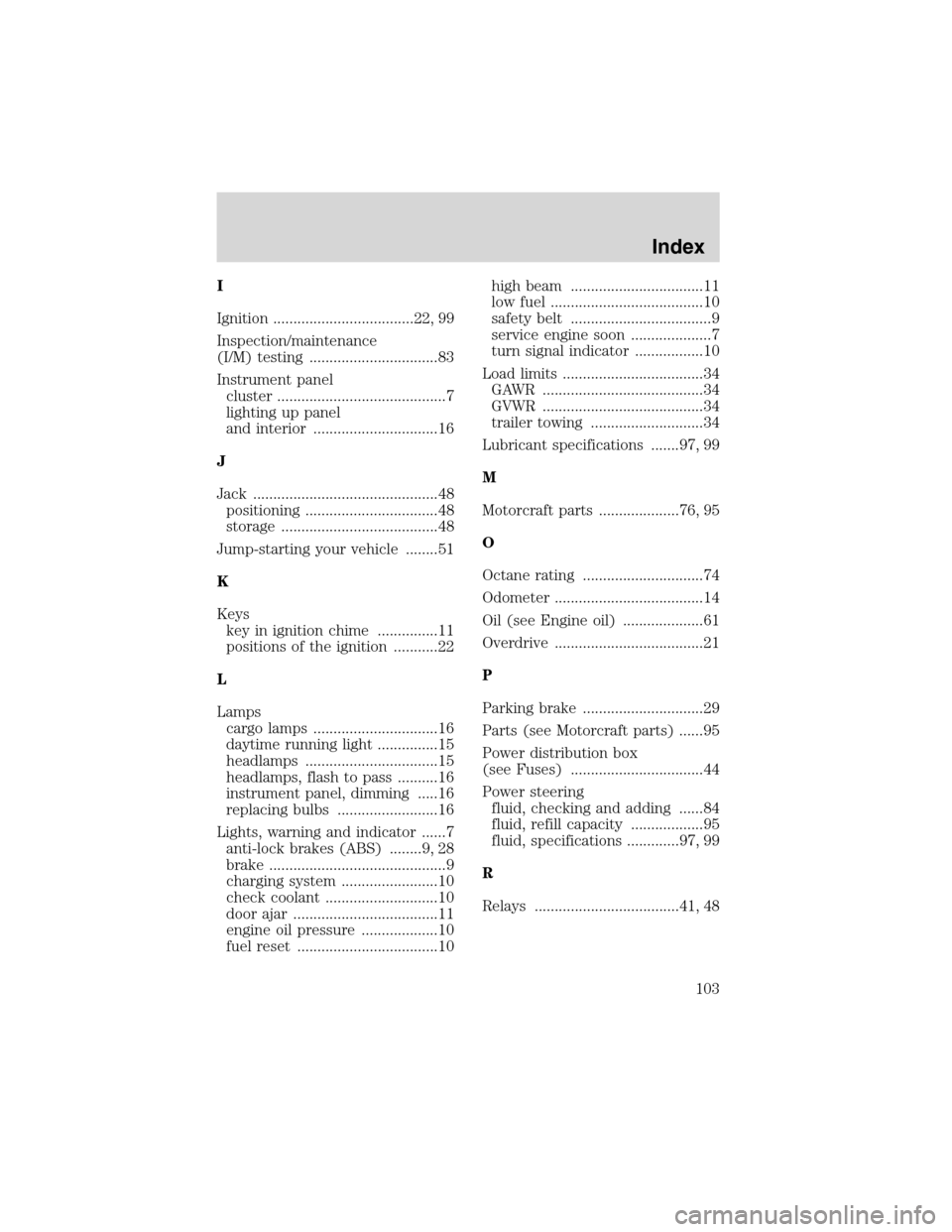
I
Ignition ...................................22, 99
Inspection/maintenance
(I/M) testing ................................83
Instrument panel
cluster ..........................................7
lighting up panel
and interior ...............................16
J
Jack ..............................................48
positioning .................................48
storage .......................................48
Jump-starting your vehicle ........51
K
Keys
key in ignition chime ...............11
positions of the ignition ...........22
L
Lamps
cargo lamps ...............................16
daytime running light ...............15
headlamps .................................15
headlamps, flash to pass ..........16
instrument panel, dimming .....16
replacing bulbs .........................16
Lights, warning and indicator ......7
anti-lock brakes (ABS) ........9, 28
brake ............................................9
charging system ........................10
check coolant ............................10
door ajar ....................................11
engine oil pressure ...................10
fuel reset ...................................10high beam .................................11
low fuel ......................................10
safety belt ...................................9
service engine soon ....................7
turn signal indicator .................10
Load limits ...................................34
GAWR ........................................34
GVWR ........................................34
trailer towing ............................34
Lubricant specifications .......97, 99
M
Motorcraft parts ....................76, 95
O
Octane rating ..............................74
Odometer .....................................14
Oil (see Engine oil) ....................61
Overdrive .....................................21
P
Parking brake ..............................29
Parts (see Motorcraft parts) ......95
Power distribution box
(see Fuses) .................................44
Power steering
fluid, checking and adding ......84
fluid, refill capacity ..................95
fluid, specifications .............97, 99
R
Relays ....................................41, 48
Index
103